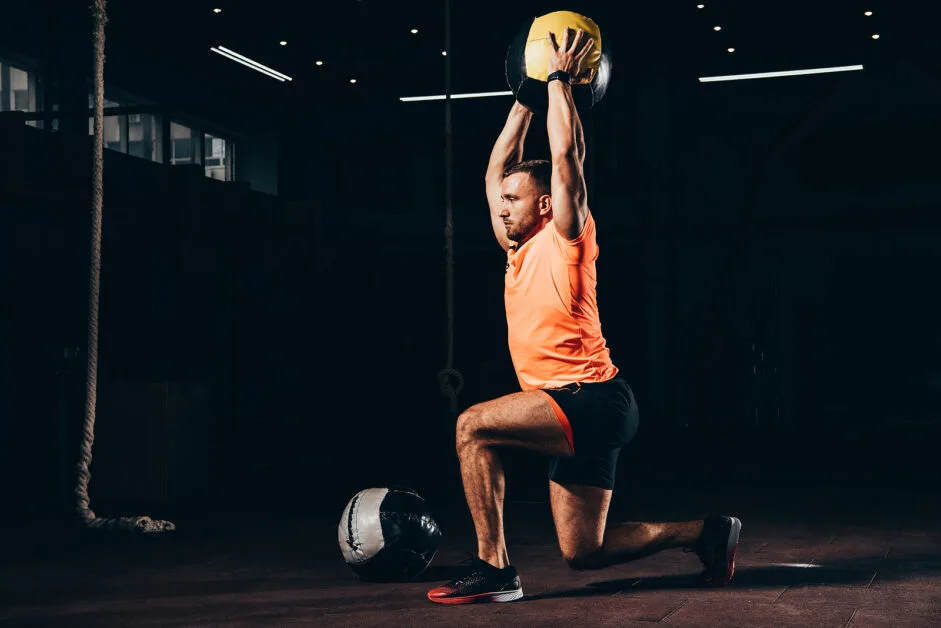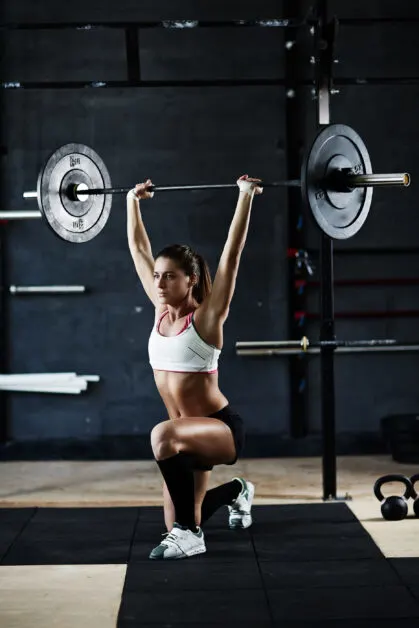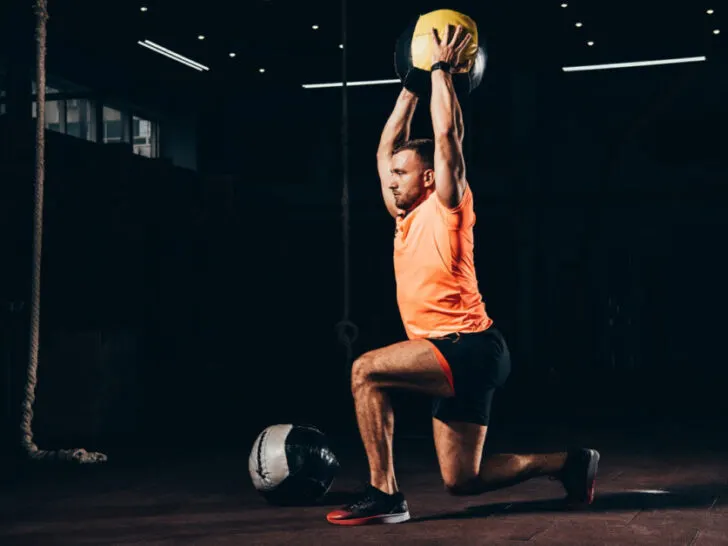Some of the links in this post are affiliate links. This means if you click on the link and purchase the item, we will receive an affiliate commission from the vendor at no extra cost to you. These business relationships allow us to keep bringing you great EatMoveHack content. All opinions remain our own.
At a Glance Info:
Targets: Nearly every muscle in your body, but especially your core, glutes, hamstrings, and shoulders
Equipment Needed: Some sort of weight (dumbbell, medicine ball, kettlebell, etc.)
Level: Advanced
We know, we know — regular lunges are challenging enough, and now we’re about to show you a way to make them even harder? Are we really that sadistic?
The answer is that we’re actually way more sadistic than that. But in the end, you’ll benefit from our mean streak, as the overhead lunge is one of the absolute best total-body exercises you can do. Because your legs are lifting your body while your upper body stabilizes the weight you’re holding overhead, virtually every muscle in your body is being targeted at the same time.
And yes, that includes the “sexy” muscles: the glutes, abs, and arms. In fact, those muscles are taxed more than just about any other with this exercise.
We’re not going to lie to you — overhead lunges aren’t fun, they’re not easy, and you’re probably not going to enjoy doing them. However, if you do them regularly, we can give you the Men’s Wearhouse promise: you’re going to like the way you look. We guarantee it.
What are Overhead Lunges and What are the Benefits?
The overhead lunge takes the basic lunge to the next level by adding a weight held above your head. This simple tweak delivers a host of benefits that make it a must-try exercise for anyone looking to build strength, stability, and athletic performance.
Full-Body Engagement
Holding weight overhead activates your shoulders and arms, forcing them to work hard to stabilize the load. At the same time, your core muscles—especially your abs—engage to maintain proper posture and keep the weight steady as you move. Your legs, as always, bear the brunt of the work, pushing the added resistance off the floor.
Build Strength and Explosiveness
The overhead lunge helps build explosive power by challenging your legs to push through the movement under additional strain. This makes it an excellent choice for athletes looking to improve their performance in sports like running, skiing, or cycling.
Boost Balance and Stability
With the weight above your head, your balance is tested as your center of gravity shifts with every step. This activates stabilizing muscles you might not typically use, improving coordination and overall body control.
Save Time While Targeting Multiple Muscle Groups
Overhead lunges offer a time-efficient workout, hitting all the major muscle groups in one exercise. While your legs and core work the hardest, your upper body still benefits by maintaining strength and tone.
Add the overhead lunge to your routine to maximize efficiency, boost athletic performance, and build full-body strength.
How to Do an Overhead Lunge Effectively
Overhead lunges are one of the best exercises you can do, but they’re not easy. It’s a fairly complex movement, and it will put a lot of strain on some areas that you might’ve ignored in your previous training regimen.
Warning! If you haven’t mastered the basic lunge, don’t jump head-first into the overhead lunge (and if you’re jumping head-first at any point during an overhead lunge, you’re doing it wrong). This is an advanced exercise, and it’s easy to injure yourself if you add it to your routine before your body’s ready.
If the regular lunge is old hat to you, however, here’s how to take your training to the next level with the overhead lunge:
Get Everything Ready

You don’t need a ton of gear to do overhead lunges, but you do need some things — namely, some sort of resistance to hold and a suitable surface to lunge on.
What you use for resistance is entirely up to you. Most people prefer dumbbells for overhead lunges, as they’re uniform in weight and easy to hold. However, others like medicine balls or kettlebells if they’re using a two-handed grip, and some people like to use sandbags because they create a dynamic challenge due to the constantly-shifting nature of the sand.
Don’t be a hero when picking the weight, either. Something that seems light when you take it off the rack will be much heavier after you’ve been holding it overhead for 10 reps, and you don’t want to risk dropping anything on your head if your grip gets weak in the middle of a rep. Start off small and work your way up.
The area in which you do your lunges needs to give you plenty of clearance, both for your legs and arms, and it needs to be a flat, stable surface. You don’t want to have to contort your body mid-lunge or risk stepping on an unbalanced surface, as either of these things can cause some pretty serious injury if things go bad at any point during the lunge.
Perform the Lunge
You should start with your feet shoulder-width apart and knees slightly bent. Inhale and raise the weight over your head — don’t start counting, as we haven’t truly started yet. This is still just preparation.
Make sure the weight is directly over your shoulders, and that your arms are locked firmly in their sockets. This will keep your shoulder muscles stable and supported throughout the exercise.
Let out your breath and take a step forward into a deep lunge. As with any exercise, form is of paramount importance here. You want your forward knee to be above the forward foot; if the knee is sticking out beyond the toes, you’re doing it wrong (and putting yourself at risk of injury).
Take a breath and then exhale forcefully as you push your forward heel into the ground, lifting yourself back to the starting position. Congratulations — you just did a successful weighted overhead lunge!
Now do 9 more and then switch legs.
Common Mistakes to Avoid When Doing Overhead Lunges
When it comes to overhead lunge mistakes, almost all of them involve using improper form. Your posture is key, as if your body isn’t properly aligned, you won’t see the same results (and you’ll put yourself at risk of injury).

That’s why it’s important to start with regular lunges before you transition to overheads. If you can’t lunge properly without weight, you have no business doing it with weights.
Again, your front knee should be over your foot, not in front of it. There should be a straight line from your midfoot up to your knee, and then your thigh should be parallel to the floor.
The weight you’re holding overhead should be kept stable and upright as well. If you feel the weight start to sink down or sway from side to side, you should either take a break or switch to less resistance.
Variations for Overhead Lunges
Given that the overhead lunge is itself a variation of a more basic exercise, we’d be remiss if we didn’t tell you to do regular lunges. They’re a great way to check your form, and they’re pretty fantastic for your lower body as well.
If you’re just starting off with overhead lunges, you might want to go extremely light with the weight. Holding a broomstick over your head is a good way to learn the movement, and it can also help with balance and stability.
Once you’ve mastered the movement, you can really challenge yourself by incorporating lateral and backwards lunges. These are very similar, except (you guessed it) they involve stepping behind you or to either side.
Another fun variation is the overhead walking lunge. These are just like regular overhead lunges, except instead of returning to your starting position at the end of the movement, you take another step forward — you know, like walking.
In addition to providing you with more interesting scenery to look at, overhead walking lunges are excellent for building balance, increasing flexibility, and developing functional fitness.
Looking for ways to work your abs? Check out our guide on how to build core strength from nothing.

